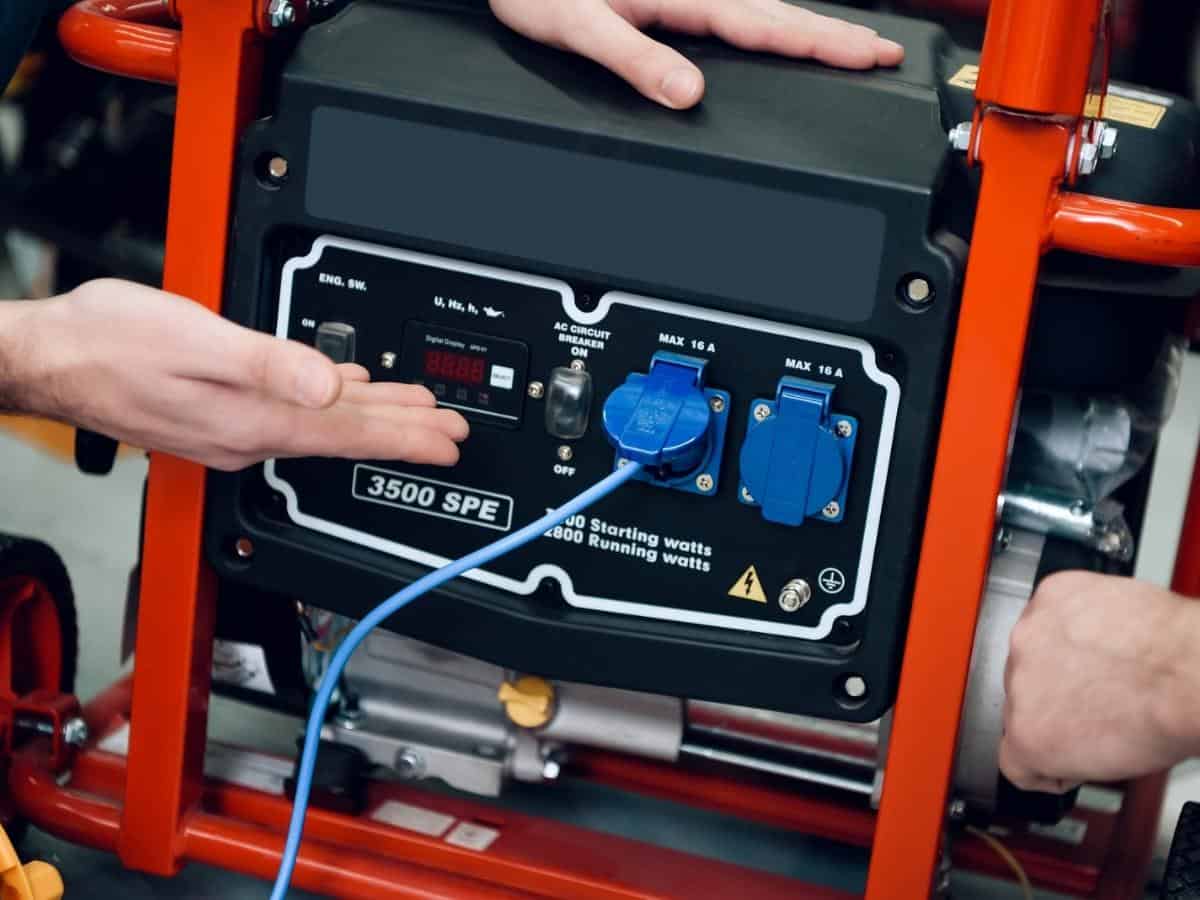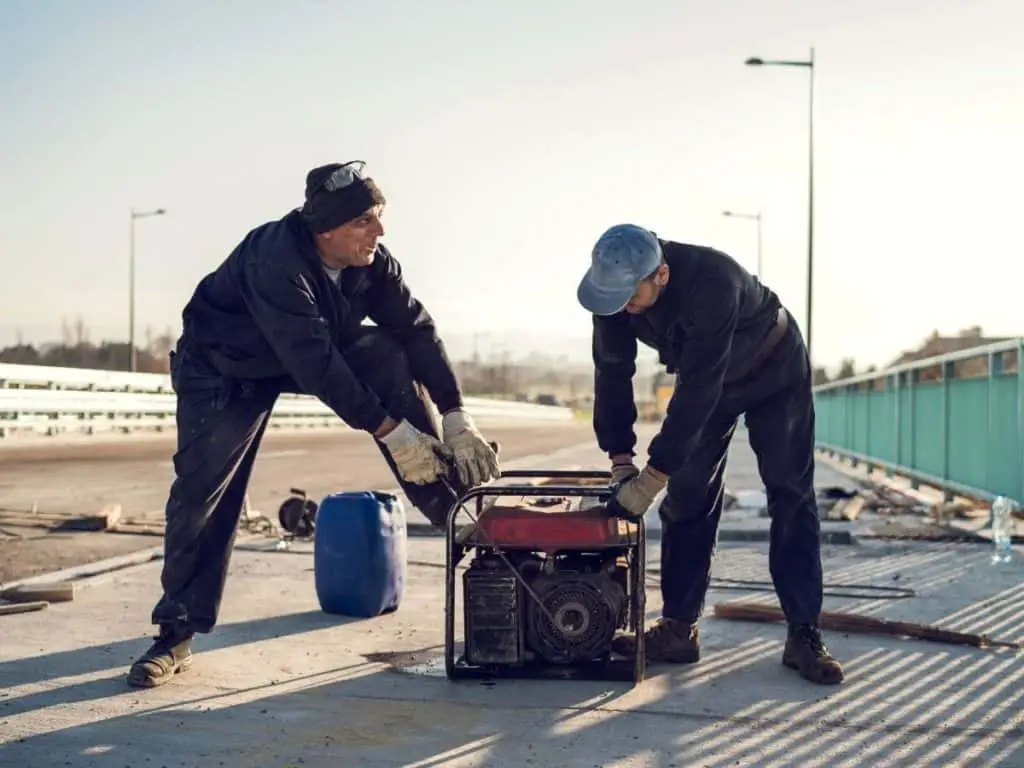Portable generators stand out as valuable tools for people who need electricity on the go. However, some question whether they can run a portable generator without a load.
You might be concerned about damaging the generator or diminishing fuel efficiency. To answer all your questions about this topic, we’ve gathered information about the following and more:
- What happens when you run a generator with no or low load
- How to calculate the minimum load
- What is wet stacking
Keep reading so that you can manage your generator’s load properly.

Can You Run a Portable Generator Without Load
In most circumstances, you don’t want to run a portable generator without a load. Since running one without a load poses some risks. We want to discuss them. We also want to mention situations where you want to run a generator without a load.
Can I Run a Generator With Nothing Plugged In?
Running your generator with nothing plugged means running it without a load. The load refers to the amount of power a generator can handle at once. When you reach the max amount of a load, the generator runs as efficiently as possible.
Because of this, if you don’t plug anything into your generator, it won’t run efficiently and can face problems.
Effect of Low Loads on Generators
If you go with a low load or none at all, you could run into the following side effects:
- It causes wet stacking to occur while damaging the generator.
- It lowers the efficiency of the generator.
- It increases fuel consumption.
If you run your generator at low loads, you can develop wet stacking in your system. While wet stacking can cause long-lasting consequences, lowering the efficiency and increasing the fuel consumption has immediate consequences.
People think they’ll use less gas by focusing on low loads, but they cause the generators to burn more fuel. Since it burns more fuel, it becomes less efficient, so you want more money.
In short, if you plan to improve your generator’s efficiency and save money, you need to get it near the maximum load.
Generator No-Load Test
Even though you don’t want to run portable generators for long periods without a load, you can run no-load tests. These tests help you check your generator in multiple ways:
- First, see if the generator properly starts.
- Check to make sure the engine runs without stopping.
- Review the control system.
You can look over your generator and identify problems by performing a no-load test. While you can do this check every week, you should avoid doing it too often.
Even though it runs a low risk of causing the effects listed above, you need to remain careful with your generators and only perform the test for a few minutes.
Generator Break-in: Load or No Load?
If you recently purchased a generator, you need to break it in. However, you may question how to go through the process. For example, do you need to do it with or without a load?
Some generators have you break them in with a partial load or none. Then, you need to run the generator for five hours or so to get the engine in the proper position. You also need to change the oil to prep your generator for use.
Keep in mind these steps apply to some generators. So if you purchase a generator, make sure you review the break-in steps to understand the process.

Generator Minimum Load
Now that you understand why a generator shouldn’t run without a load, you must identify the minimum load. The minimum load refers to the least amount of power you can plug into the generator without causing damage to it.
What Is the Minimum Load Ratio for a Diesel Generator?
The minimum load ratio lets you know the least amount of power your generator can use to function correctly. While some generators let you run them at lower amounts, doing so runs risks for you and the generator.
While generators work best at max capacity, not everyone has enough electronics. If you want to minimize it as much as possible, you should aim for at least 30 percent or higher as a general rule.
Remember that this is a general rule so it can vary depending on your generator. You want to avoid the minimum load ratio whenever you can.
What Happens When a Load on a Generator Increases?
Not all generators have the same loads. On top of this, you can upgrade your generator to a larger size or improve it based on what you purchase. You need to know your new load to adjust your use of it.
When your generator can hold a more significant load, you need to add more power to keep it between the minimum and maximum loads. Because of this, your previous setup might not work, so you need to use more power to maintain your generator and avoid problems.
Can You Run a Generator to Empty?
Since portable generators run with gas in them, some people question if they should run them until they become empty. After all, what if the generator poses a fire hazard if you don’t empty it before you store it?
Should I Run My Generator Dry for Storage?
People wonder if they need to run their generators before storing them. It depends on how you plan to store the generator since it can pose a danger.
For example, you don’t need to secure the generator if you empty it before storing it. In addition, since it doesn’t pose a fire hazard if you store it without oil or gas, you don’t need to follow HMR storage requirements.
If you don’t empty it, you need to follow multiple rules, including keeping it locked up, closing the generator completely, and leaving it in an open area to prevent gas leaks from harming people.
Make sure you research the subject to determine if your storage methods work or if you need to run your generator dry first.

Generator Load FAQs
Now that we talked about portable generators and loads, we want to mention frequently asked questions (FAQs) about loads. That way, you can find quick answers to help you take care of your portable generator.
Can you run a generator without anything plugged into it?
Yes, but you need to consider the situation. For example, if you plan to run it for a long time, you shouldn’t run the generator without anything plugged in. But, on the other hand, you can do so if you want to perform tests.
However, if you plan to reduce the gas in the generator, you should plug it in to avoid damage.
What is the minimum load for a generator?
The minimum load for a generator varies depending on the generator type. While generators need to run at max capacity when possible, you can see if the instructions mention a minimum load. However, generators can be dangerous and deadly, so focus on safety.
What happens if a generator is underloaded?
If a person underloads the generator, they run multiple risks. They can run the fuel out quickly, damage the generator, and face potential fire hazards. So while you can underload a generator, you must avoid it when possible.
What is wet stacking a generator?
Wet stacking refers to build-up in the exhaust systems. Wet stacking forms from the gas and oil as it leaks a damaging substance into the generator. When you run light loads, it may damage the generator and pose a fire hazard.
Sources:
- https://digitalcommons.odu.edu/cgi/viewcontent.cgi?article=1024&context=emse_etds
- https://www.energy.gov/sites/default/files/2019/11/f68/21-fupwg-fall-2019-bond.pdf
- https://www.energy.gov/sites/default/files/2020/05/f75/3_Schenkman_Sandia.pdf
- https://dot.alaska.gov/stwddes/research/assets/pdf/ak_rd_90_09.pdf
- https://vtechworks.lib.vt.edu/bitstream/handle/10919/78374/Wheeler_KR_T_2017.pdf?sequence=1




